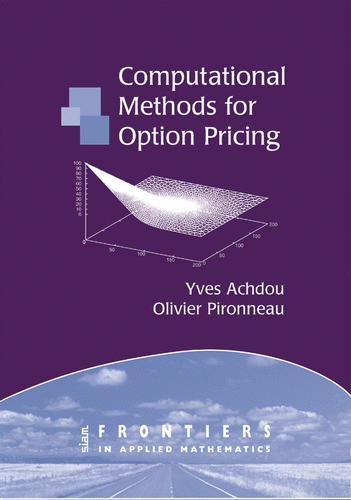Computational Methods for Option Pricing, by Y. Achdou and O. Pironneau, SIAM, Philadelphia, (2005), 297 pp., $80.00, ISBN 0898715733.
The application of numerical methods to accurately solve problems in Finance has attracted considerable interest over the last three decades. Recently, there has been a flurry of books on the subject, as well as a dedicated journal. Yves Achdou and Olivier Pironneau add to this list with their book Computational Methods for Option Pricing, published by the SIAM Frontiers in Applied Mathematics series. The book grew out of two graduate courses the authors taught at the University of Pierre and Marie Curie in Paris for students in Numerical Analysis with an interest in financial applications.
The authors research expertise is in the area of finite element methods for solving partial differential equations and in the calibration of volatility surfaces from European and American option prices, and these are the topics emphasized in the book. The authors take a rigorous approach, and the reader who would benefit most is one who already has a strong background in both computational and applied mathematics and option pricing (such as exposure to Hilbert and Sobolev spaces, numerical methods for solving full and sparse linear systems, and volatility smiles). This audience includes a growing group of professionals in the financial industry, who have a background in Physics or Mathematics.
The book is divided into nine chapters. A brief overview of option pricing in the Black–Scholes framework is provided in chapter 1, where the authors also discuss numerical methods based on the stochastic differential equation representation of option prices: Monte-Carlo simulation and binomial trees. The second chapter introduces the partial differential equation (PDE) representation of option prices, and the authors derive theoretical properties of solutions that are useful in determining the accuracy and convergence of numerical approximations. These results are applied in the discussion of finite difference and finite element integration schemes, discussed in chapters 3–5. In these chapters the authors articulate their philosophy on numerical methods for option pricing: since options are the solutions of PDEs with irregular boundary conditions (for example, European payoffs with discontinuous derivatives or American options that introduce a free boundary), one should use grids adapted to the natural variation of the solution. This is best achieved by adaptive mesh refinement developed in the context of finite element methods. Following this philosophy, they provide a good introduction to the finite element method and to adaptive mesh refinement, as well as code for the implementation of the methods (the code is available through a website maintained by the authors). Although there are cases where finite element methods are difficult to apply—for example, in the case of a large number of state variables—the authors make a good case that there is more room for their application than what has traditionally been the case.
In chapter 7 the authors focus on calculating derivatives of option prices and present a method that has received little attention, automatic differentiation of computer code, as well as better known simulation methods based on Malliavin calculus. The authors note that automatic differentiation has many advantages but may lead to mistakes as well, especially for non-differentiable functions, such as the second derivatives of call or put payoffs.
Chapters 8 and 9 describe the calibration of the local volatility surface using European and American option prices, and Tychonoff regularization. The results from the earlier chapters on pricing options using finite element methods come in handy, as they are used to efficiently estimate option prices given a volatility surface.
Throughout the book the authors provide careful numerical analysis and tight error estimates. In providing these estimates they assume that the inputs, i.e. parameter estimates for option pricing and option prices for volatility calibration, are accurate. It is hardly the authors' fault that this is rarely the case in practice, where one often faces the problem of maximizing accuracy given inaccurate inputs and/or a fixed time budget. Indeed, I believe that the methods they describe are powerful enough to handle such real-life problems.
Although I wish editing would have streamlined the prose, and improved the graphs in the book, I did find the text clear. I would recommend the book to anyone with the appropriate background who is interested in speeding up their calculations of option prices using finite element methods.
